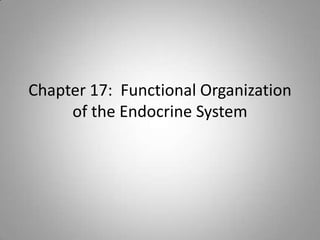
A&pi ichapter17
- 1. Chapter 17: Functional Organization of the Endocrine System
- 2. Principles of Chemical Communication • Chemical Messengers – Allow cells to communicate with each other to regulate activities – 4 classes of chemical messengers based on the source of the chemical messenger and its mode of transport in the body • Autocrine chemical messengers • Paracrine chemical messengers • Neurotransmitters • Endocrine chemical messengers
- 4. Characteristics of the Endocrine System • Composed of endocrine glands and specialized endocrine cells located throughout the body • Secrete minute amounts of chemical messengers (hormones) into the bloodstream • Hormones travel a distance from their source through the bloodstream to specific sites (target tissues or effectors)
- 7. Comparison of the Nervous System and Endocrine Systems • Nervous system and the endocrine system regulate and coordinate the activities of essentially all body structures to achieve and maintain homeostasis – Nervous system functions as a communication system – Endocrine system sends information to the cells it controls in the form of hormones, which are carried by the bloodstream to all parts of the body
- 8. Similarities • Structures associated with the brain – E.g. hypothalamus • Same molecule is a neurotransmitter for the nervous system and a hormone for the endocrine system – E.g. epinephrine • Work together to regulate critical body processes – E.g epinephrine
- 9. Similarities cont. • Some neurons secrete hormones – Neuropeptides (neurohormones) – E.g. oxytocin
- 10. Differences • Mode of transport – Endocrine system secretes hormones which are transported in the bloodstream – Nervous system secretes neurotransmitters which are released directly onto their target cells • Speed of response – Nervous system responds faster than the endocrine
- 11. Differences cont. • Duration of response – Nervous system activates its targets quickly – Endocrine system tends to have longer-lasting effects
- 12. Hormones • Characteristics – Stability • Life span of hormone varies with its chemical nature • Expressed as half-life – amount of time it takes for 50% of the circulating hormone to be removed from the circulation and excreted – Communication • Able to regulate specific cellular pathways once they arrive at their targets – Distribution • Transported by the blood to many locations
- 13. Chemical Nature of Hormones • Lipid soluble – Steroid hormones, thyroid hormones and fatty acid derivative hormones – Travel in bloodstream bound to binding proteins • Water soluble – Protein hormones, peptide hormones and most amino acid derivative hormone – Circulate as free hormones – Relatively short half-lives
- 16. Patterns of Hormone Secretion • 3 main patterns of hormone secretion – Chronic hormone secretion – Acute hormone secretion – Episodic hormone secretion • Steroid reproductive hormones
- 17. Control of Hormone Secretion • 3 types of stimuli regulate hormone release – Humoral • Blood-borne molecules can directly stimulate the release of some hormones – Neural • Involves neural stimuli of endocrine glands – Hormonal • Hormone is secreted that stimulates the secretion of other hormones
- 18. Control by Humoral Stimuli
- 19. Control by Neural Stimuli
- 20. Control by Hormonal Stimuli
- 21. Regulation of Hormone Levels in the Blood • 2 major mechanisms – Negative feedback • Most hormones are regulated
- 22. • Positive feedback – Example:
- 23. Hormone Receptors and Mechanisms of Action • Hormones exert their actions by binding to proteins called receptors – Only can stimulate cells that have the receptor for that hormone – Specific
- 24. • Down regulation • Up regulation
- 26. Classes of Receptors • Lipid-soluble hormones bind to nuclear receptors – Relatively small – Able to diffuse through the plasma membrane and bind to nuclear receptors
- 27. • Water-soluble hormones bind to membrane- bound receptors – Large molecules and cannot pass through the plasma membrane – Interact with membrane-bound receptors
- 28. Action of Nuclear Receptors
- 29. Membrane-Bound Receptors and Signal Amplification • Membrane-bound receptors activate responses in 2-ways – Receptors may alter the activity of G proteins at the inner surface of the plasma membrane – Receptors may directly alter the activity of intracellular enzymes – Second messenger system
- 30. Receptors that activate G Proteins • G proteins – 3 subunits • Alpha, beta and gamma • Guanine nucleotide bound to alpha subunit – Inactive state – GDP bound – Active state – GTP bound
- 32. G proteins that Interact with Adenylate Cyclase
- 33. G Proteins that Activate other Intracellular Mediators • Alter the concentration of intracellular mediators other than Ca2+ or cAMP
- 34. Receptors that Directly Activate Intracellular Mediators
- 35. Receptors that Phosphorylate Intracellular Proteins • Hormones bind to membrane-bound receptors. • Part of receptor protein on inside of membrane acts as an enzyme to phosphorylate proteins • E.g., insulin receptors bound to insulin cause phosphorylation of proteins and cell responds to presence of insulin.